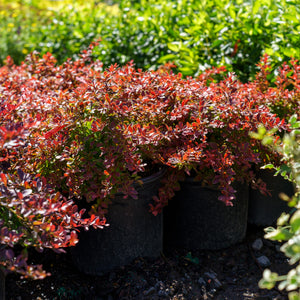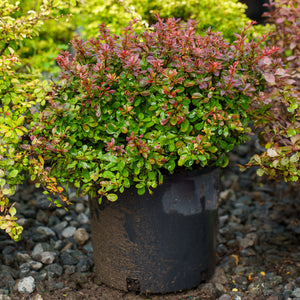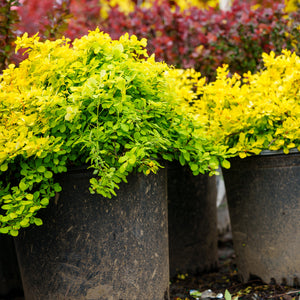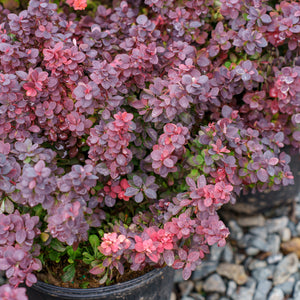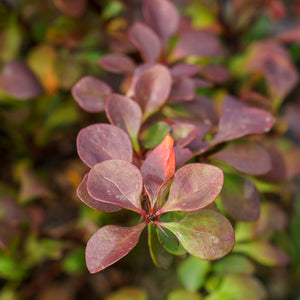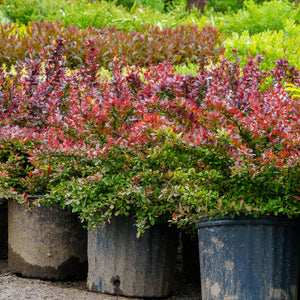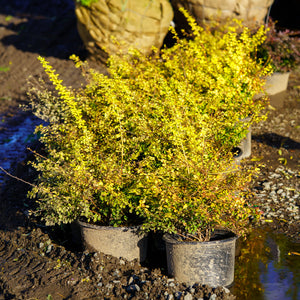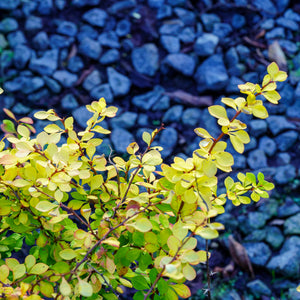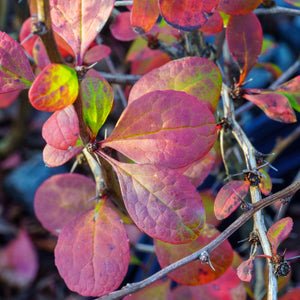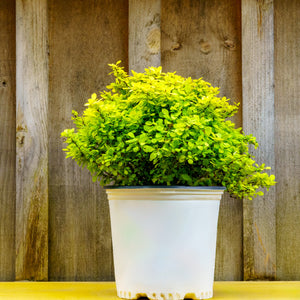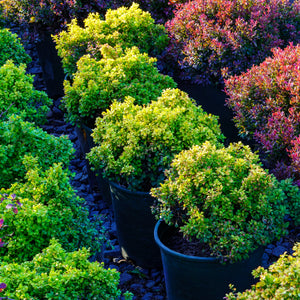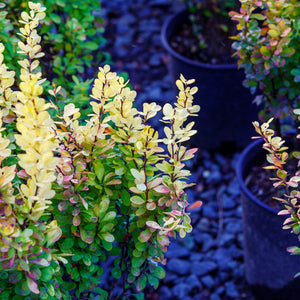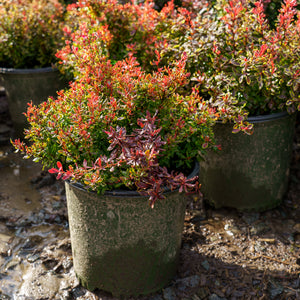The Barberry Guide
Barberry (Berberis) is a colorful, durable group of deciduous shrubs celebrated for richly hued foliage, compact forms, and exceptional landscape utility. With cultivars spanning saturated burgundy, ember orange, neon chartreuse, gold, and variegated mixes, barberries provide long-running color from spring through late fall, often ending with fiery autumn tones and small red berries that persist into winter. Their dense branching and short spines create tidy, low-maintenance mounds perfect for borders, foundations, and mass plantings, while upright selections function as narrow hedges or architectural accents. In regions with browsing pressure, barberry’s natural deer resistance makes it a reliable performer.
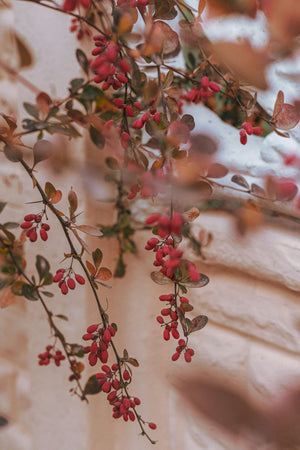
About
Barberries (Berberis) are a remarkably versatile group of deciduous - and in mild climates, sometimes semi-evergreen - shrubs that bring enduring color, texture, and structure to contemporary landscapes. Belonging to the Berberidaceae family, they are celebrated for densely branched habits, short protective spines, and small, lustrous leaves that hold saturated pigment from spring through frost. Across the genus you’ll find mounded cushions, ground-hugging dwarfs, and slender columns, all unified by exceptional durability and a talent for delivering multi-season interest with minimal care.
Foliage is the headline act. Depending on the cultivar, leaves can emerge neon chartreuse, mature to burnished gold, glow ember-orange, or read as deep wine and velvety burgundy, often intensifying to brilliant scarlet or copper in autumn. In spring, unobtrusive yellow flowers hum with early pollinator activity; by late season, many selections ornament themselves with glossy red berries that persist into winter and provide food and cover for birds. This blend of long-running color, fine texture, and wildlife value makes barberry a natural fit for foundation plantings, mixed borders, slope stabilization, low hedging, and high-contrast focal points.
Adaptability is another hallmark. Barberries thrive in full sun (where foliage color is most vivid) but tolerate light shade; they accept a wide range of soils so long as drainage is reasonable; and once established they handle heat, periodic drought, urban conditions, and even roadside salt with poise. Their thorny architecture also discourages deer and foot traffic, lending them a practical role as deterrent hedge beneath windows or along property edges.
Within our collection, you’ll find compact burgundy and red workhorses such as Concorde, Crimson Pygmy, Royal Burgundy, Pygmy Ruby, Crimson Cutie, and Fireball; variegated or multitone standouts like Rose Glow, Admiration, Golden Ruby, and Limoncello; gold and chartreuse beacons including Golden Barberry, Bonanza Gold, Golden Nugget Dwarf, Golden Carousel, Golden Jackpot, Sunsation, Lemon Glow, Sunjoy Citrus, and Sunjoy Golden Pillar; vertical accents like Helmond Pillar, Golden Rocket, and Orange Rocket; and modern Sunjoy introductions - Neo, Tangelo, Mini Maroon - that combine bold color with tidy, landscape-ready habits. Selections marketed as Wintergreen or William Penn extend seasonal foliage in mild regions and underscore the breadth of form and performance available within Berberis.
As with any widely planted ornamental, it’s wise to match cultivar to region. Some Japanese barberry types are regulated in certain states due to invasive potential; region-appropriate or sterile selections are available where restrictions apply. Chosen thoughtfully and sited in sun with decent drainage, barberries deliver reliable color, wildlife support, and year-round structure - an elegant, resilient backbone for gardens from formal courtyards to naturalistic slopes.
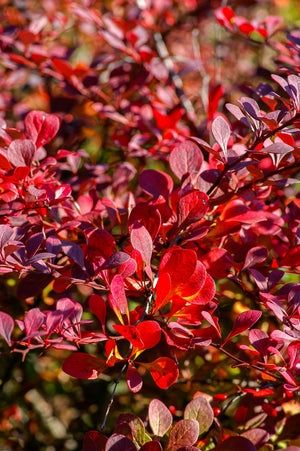
Planting
Barberries reward from the start with dense color, compact habit, and long-term vigor. Use the guidelines below to set them up for success.
USDA Hardiness Zones: Most Berberis thunbergii cultivars perform in Zones 4–8, with a few stretching into Zone 9. Confirm the specific cultivar’s rating before planting.
Soil: Barberries thrive in well-drained soils. Loam is ideal, but they adapt to clay or sandy substrates once established. Aim for a slightly acidic to neutral pH (about 6.0–7.2). Before planting, loosen the top 8–12 inches of soil and blend in 2–3 inches of compost to improve structure and drainage. Avoid chronically wet sites; standing water leads to root decline.
Sunlight: Full sun (at least six hours daily) produces the richest foliage color and the densest, most compact form. In hot summer regions, a touch of afternoon shade can prevent leaf scorch on golden or chartreuse selections such as Sunsation, Golden Nugget Dwarf, or Limoncello. Burgundy and red types like Concorde, Crimson Pygmy, and Royal Burgundy hold best color in strong light.
Watering: Water thoroughly at planting to settle soil around the roots, then maintain even moisture through the first growing season. A deep soak once or twice per week is usually sufficient, adjusting for rainfall and heat. After establishment, barberries are moderately drought tolerant and need only occasional deep watering during extended dry periods. Avoid “little and often” sprinkling, which encourages shallow rooting.
Spacing: Match spacing to the mature width of the cultivar and your design intent. Dwarf mounds such as Concorde, Bagatelle, Golden Nugget Dwarf, and Sunjoy Mini Maroon are typically spaced 18–30 inches on center for edging or massing. Medium mounds like Crimson Pygmy, Golden Ruby, Fireball, and Sunjoy Neo usually need 24–36 inches. Columnar accents including Helmond Pillar, Golden Rocket, Sunjoy Golden Pillar, and Orange Rocket are commonly set 24–36 inches apart for tight hedges or vertical rhythm. Leave a few extra inches if you want air gaps between plants.
Planting Time: Plant in spring after the soil is workable or in early fall while soil temperatures remain warm. Spring planting is safest in colder climates; fall planting is excellent in warmer zones because roots continue to grow into early winter. Container-grown plants can go in during the growing season if you can water consistently.
Planting Technique: Dig a hole as deep as the root ball and 2–3 times as wide. Set the shrub so the top of the root ball is level with surrounding soil, backfill with the native soil/compost blend, and firm gently to remove air pockets. Water deeply, then add a 2–3 inch mulch ring.
Mulching: Apply shredded bark or wood chips in a broad ring to conserve moisture, moderate soil temperature, and suppress weeds. Keep mulch a few inches away from the stems to prevent excess moisture against the crown.
Initial Training and Pinching: Barberries generally do not require pruning at planting, but a light tip-pinch on lanky shoots after the first flush can encourage branching on mounded forms. Upright pillars typically need no heading at installation.
Regional and Regulatory Note: Japanese barberry is restricted in some regions due to invasive potential. Check local guidance before planting and select approved or sterile cultivars where required. In all regions, promptly remove any volunteer seedlings that appear beyond planting beds.
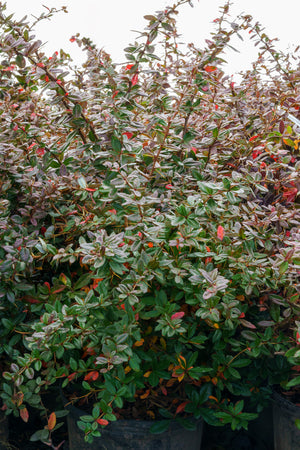
Care
Barberries require specific care practices to ensure their optimal growth and vitality. Here are comprehensive guidelines for the care of barberries, ensuring they grace your garden with enduring beauty:
Watering: Keep soil evenly moist through the first growing season to establish deep, resilient roots. A thorough soak once or twice per week is typically sufficient, adjusted for rainfall, heat, and soil type. After establishment, barberry tolerates periodic drought; water deeply during extended dry spells rather than giving frequent, shallow sprinkles. Avoid waterlogged sites or chronic overwatering, which can lead to root decline.
Fertilizing: In average garden soil, barberry needs little to no fertilizer. If growth is weak or leaves appear pale, apply a balanced, slow-release fertilizer in early spring at label rates. Excess nitrogen can diminish foliage color intensity and encourage lank, sappy growth, so err on the light side. Annual compost top-dressing around the dripline is often all that’s required.
Pruning: Light shaping immediately after the spring flush (or after flowering) keeps mounded cultivars dense and compact. Use selective thinning cuts to open the plant and remove twiggy clutter; avoid heavy shearing late in the season, which may stimulate tender growth before frost. For rejuvenation, remove up to one-third of the oldest stems at the base in late winter. Columnar selections (Helmond Pillar, Golden Rocket, Orange Rocket, Sunjoy Golden Pillar) can be tip-pruned after bloom to maintain a narrow profile without losing structure.
Soil and Sunlight: Barberries prefer well-drained soils and perform best in full sun. Six or more hours of direct light delivers the richest foliage color and tightest habit. In hot climates, provide light afternoon shade for golden/chartreuse cultivars (Sunsation, Golden Nugget Dwarf, Limoncello) to reduce leaf scorch. They tolerate a wide pH range, but slightly acidic to neutral soils (about 6.0–7.2) are ideal.
Mulching: Maintain a 2–3 inch layer of shredded bark or wood chips over the root zone to conserve moisture, suppress weeds, and moderate soil temperature. Keep mulch a few inches away from the stems to prevent excess moisture against the crown.
Pests and Diseases: Barberry is generally trouble-free. Periodic aphids or scale may appear; strong water sprays or labeled horticultural oils usually suffice. In humid regions, leaf spot can occur - improve air circulation with sensible spacing, water at the base, and remove fallen leaves in autumn. Root issues almost always trace back to poor drainage; correct grading or relocate plants if saturation persists.
Winter Care: In cold, windy sites, a late-fall watering before the ground freezes helps prevent winter desiccation. Young plants benefit from a protective mulch blanket (not piled against stems). Established shrubs are quite hardy; break heavy, wet snow loads from upright cultivars to preserve shape.
Wildlife and Browsing: Thorny branching and leaf texture make barberry reliably deer resistant, though no plant is completely deer-proof. Rabbits usually avoid mature, spiny stems; protect new plantings with guards if winter browsing is severe.
Safety and Pets: The bright red berries are ornamental and provide winter interest, but ingestion of plant parts can cause mild gastrointestinal upset in pets. Discourage chewing and contact a veterinarian if significant ingestion occurs.
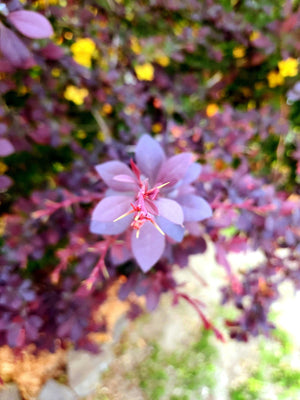
How To Use
Focal point color accents: Use barberry as a living exclamation point where season-long color matters. Burgundy and red cultivars such as Concorde, Crimson Pygmy, Royal Burgundy, Crimson Cutie, Fireball, and Pygmy Ruby read like flowers from spring to frost and intensify in autumn. Place a single specimen near an entry, anchor the corner of a front bed, or echo color along a pathway for rhythm. Gold and chartreuse selections like Sunsation, Golden Nugget Dwarf, Golden, Bonanza Gold, Golden Carousel, Golden Jackpot, Lemon Glow, Limoncello, and Sunjoy Citrus create luminous focal points that brighten shade edges and make dark evergreens pop.
Low hedges and edging: For crisp, low borders that define beds and walkways without constant shearing, mass compact mounded types 18–30 inches apart. Concorde, Bagatelle, Golden Nugget Dwarf, Golden Ruby, Sunjoy Mini Maroon, and Crimson Pygmy form neat, knee-high ribbons that suppress weeds and deliver reliable color. For a slightly taller edging with bolder presence, choose Golden Ruby, Fireball, or Sunjoy Neo at 24–30 inches on center.
Narrow screens and vertical structure: When space is tight but height or punctuation is needed, columnar cultivars provide upright architecture without the footprint. Helmond Pillar, Golden Rocket, Orange Rocket, and Sunjoy Golden Pillar can flank gate openings, frame mailboxes or address stones, and march in staggered rows to create sightlines. Use 24–36-inch spacing for a continuous narrow hedge, or widen gaps to showcase each plant as a repeating accent.
Mass plantings and slopes: Mid-sized barberries excel in sweeps where long views count. Royal Burgundy, Golden Carousel, Golden Jackpot, Sunsation, and Sunjoy Tangelo knit together into colorful drifts that read clearly from the street and stabilize banks. Their dense branching and thorny texture deter foot traffic on slopes, helping prevent erosion and shortcutting.
Foundation and front-of-house design: Pair dependable mounded barberries with textural evergreens for four-season structure. Crimson Pygmy or Sunjoy Mini Maroon in front of boxwood or yew offers a refined, high-contrast band. Use chartreuse selections (Sunsation, Lemon Glow, Limoncello) to brighten north and east exposures; echo their color with hosta, Hakonechloa, or juniper for continuity.
Mixed borders and color artistry: Play complementary palettes for sophisticated effects. Burgundy foliage (Concorde, Royal Burgundy, Crimson Cutie) intensifies beside blue conifers, lavender, nepeta, perovskia, and salvia. Gold and chartreuse forms (Golden Nugget Dwarf, Sunjoy Citrus) glow against dark evergreens and purple perennials (heuchera, baptisia). Variegated and multitone cultivars (Rose Glow, Admiration, Golden Ruby, Limoncello, Sunjoy Tangelo) provide internal contrast within a single plant, ideal for tying disparate colors together in a border.
Containers and courtyards: Dwarf selections thrive in large pots for patios, balconies, and storefronts, delivering tidy form and durable color with minimal maintenance. Choose Bagatelle, Golden Nugget Dwarf, Concorde, or Sunjoy Mini Maroon in 16–20-inch containers with sharp drainage. Underplant with seasonal annuals (lobelia, calibrachoa) or cool-tolerant perennials (thyme, sedum) to soften the rim. In mixed patio groupings, use a columnar barberry like Helmond Pillar as the vertical element.
Security and deterrent plantings: The short spines and dense branching are an asset around utilities, beneath first-floor windows, or along property edges where you want visual appeal and gentle discouragement. Royal Burgundy, Sunsation, and Orange Rocket create attractive but uninviting passages that steer foot traffic without hard fencing.
Pollinator and wildlife-savvy beds: Spring flowers support early pollinators, and berries feed birds into winter. Interplant barberries with nectar-rich companions - spirea (‘Gold Mound’ or ‘Double Play’ selections), allium, thyme, and coreopsis to build layered habitat while keeping maintenance low.
Design tips for cohesion: Repeat one cultivar in several parts of the garden to create continuity, then weave in a contrasting color as an accent. Use odd-number groupings (3, 5, 7) for natural-looking drifts. In hot zones, position gold/chartreuse cultivars where they receive morning sun and light afternoon shade to preserve color and avoid scorch; reserve all-day sun for deep burgundy forms (Concorde, Royal Burgundy) to keep them saturated and compact.
Conclusion
In contemporary landscape design, barberries excel as reliable, four-season workhorses that deliver saturated foliage color, tidy structure, and practical function with minimal fuss. From luminous golds and chartreuse tones to velvety burgundies and variegated patterns, Berberis brings the kind of long-running color normally reserved for flowers—yet holds it from spring to hard frost. Dense branching, compact habits, and short spines translate into living architecture that defines spaces, guides circulation, and provides gentle security where you need it most.
Barberries are as useful as they are beautiful. Mounded dwarfs form crisp edging and weed-suppressing drifts. Upright columns punctuate beds, frame entries, and build narrow hedges where space is tight. Mid-sized selections stabilize slopes and read clearly from the street in mass plantings. Their spring flowers support early pollinators, while glossy red berries extend visual interest and offer winter food for birds. In regions with browsing pressure, barberry’s thorny texture and tough leaves add welcome resilience.
Design compatibility is another strength. Burgundy cultivars pair effortlessly with blue conifers, lavender, and silver-leaved perennials; gold and chartreuse forms brighten shade edges and play beautifully against dark evergreens; multitone and variegated selections tie mixed palettes together in a single planting. Repeating one cultivar for cohesion, then introducing a contrasting color as a focal point, creates professional polish with very little maintenance.
Plant thoughtfully—sun for the richest color, drainage for lasting vigor, sensible spacing for airflow—and barberries will repay you with decades of dependable performance. Where regional regulations apply, select permitted or sterile cultivars and promptly remove volunteer seedlings beyond beds. With the right choices and straightforward care, Berberis becomes a durable backbone of the garden: a colorful, structural, and wildlife-friendly presence that keeps your landscape sharp, seasonal, and effortlessly compelling year after year.

